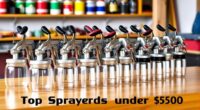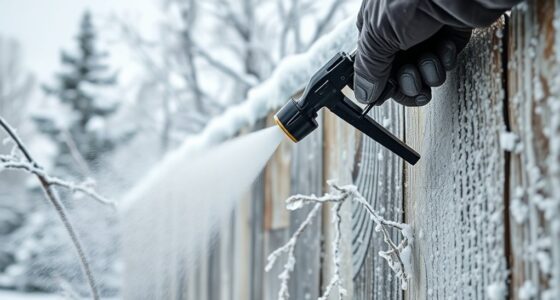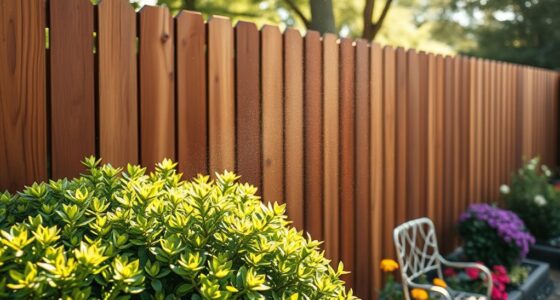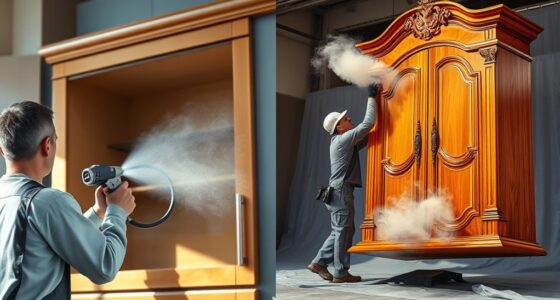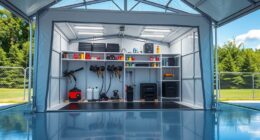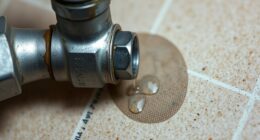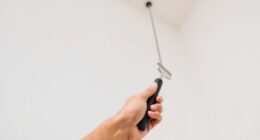To paint masonry and concrete with an airless sprayer, choose equipment with high pressure and appropriate tips for the thick, textured surfaces. Prepare your surfaces by cleaning, repairing cracks, and applying primer. Use steady, overlapping strokes and maintain the right distance from the surface. Keep your sprayer clean and adjusted for best results. For detailed steps and tips, explore the full guide to achieve a smooth, professional finish.
Key Takeaways
- Select a high-pressure airless sprayer with appropriate tip sizes for thick masonry or concrete paints.
- Prepare surfaces thoroughly by cleaning, repairing, sanding, and applying primer for optimal adhesion.
- Maintain a consistent spray distance of 12-18 inches and use steady, overlapping strokes for even coverage.
- Adjust sprayer pressure and spray pattern based on surface texture and paint viscosity for best results.
- Clean and maintain the sprayer system after use to ensure longevity and consistent performance.
Selecting the Right Airless Sprayer for Masonry and Concrete
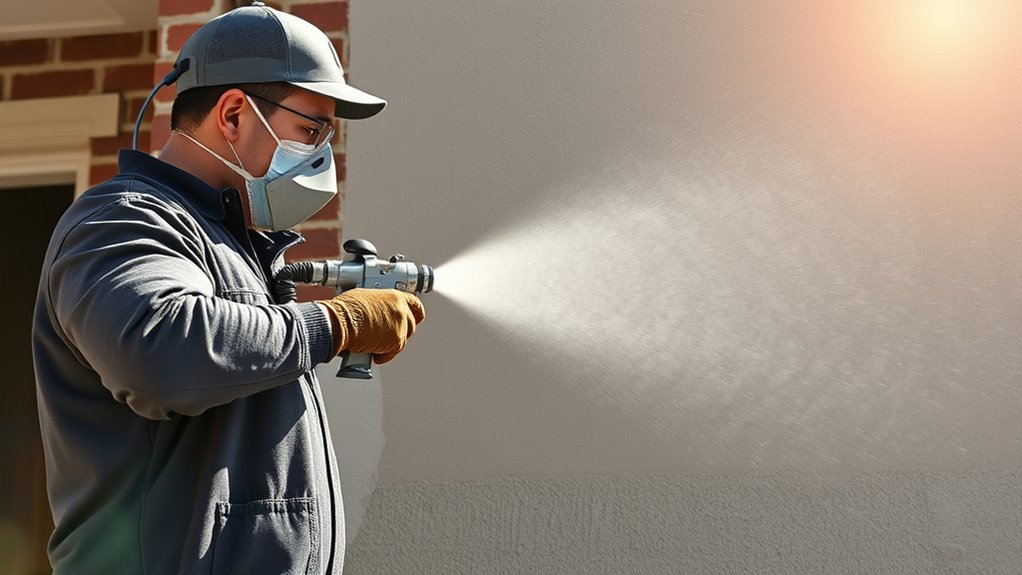
Choosing the right airless sprayer is essential for achieving professional results when painting masonry and concrete. Your first step is understanding brush selection, which influences how the sprayer handles thick masonry paints. Opt for a sprayer with a high pressure capacity and suitable tip sizes to ensure even coverage without drips. Pay close attention to paint compatibility; some sprayers work better with thicker, textured paints used on masonry and concrete surfaces. Using a sprayer incompatible with your paint can cause clogging or uneven application. Consider the spray pattern and flow rate to match your project size and surface texture. Additionally, selecting equipment with durability and reliability features ensures consistent performance over time. By selecting a sprayer that aligns with your paint’s viscosity and choosing the right brush and tip, you’ll achieve smooth, professional-looking finishes.
Preparing Masonry and Concrete Surfaces for Painting
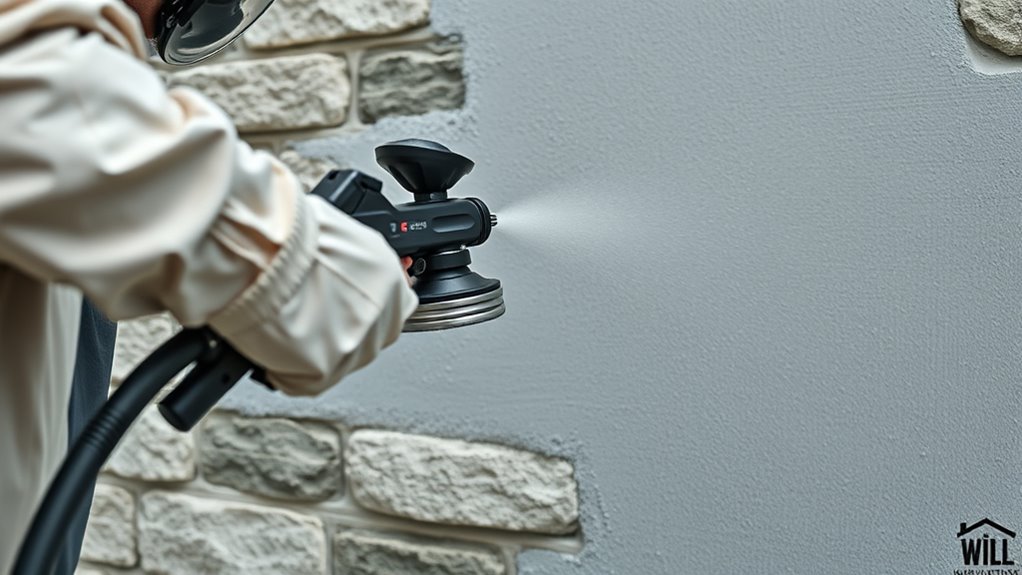
Before painting masonry and concrete, you need to properly prepare the surfaces to guarantee long-lasting, professional results. Surface preparation involves cleaning, repairing, and ensuring a smooth base. Remove dirt, grease, and loose debris with a stiff brush or pressure washer. Repair cracks and chips with appropriate fillers. Once clean and smooth, apply a primer to improve adhesion and durability. Primer application is vital for sealing porous surfaces and ensuring even paint coverage. Properly prepared surfaces prevent peeling and extend the paint’s lifespan. Use the table below for quick reference:
| Step | Action | Tip |
|---|---|---|
| Cleaning | Power wash or scrub surfaces | Remove all contaminants |
| Repairing | Fill cracks and chips | Let filler dry fully |
| Sanding | Smooth rough areas | Use medium grit sandpaper |
| Primer Application | Apply primer evenly with a brush or sprayer | Wait until fully dry |
| Final Check | Inspect for flaws | Address issues before painting |
Proper Technique for Using an Airless Sprayer on Hard Surfaces

Using an airless sprayer on hard surfaces requires careful technique to achieve an even, professional finish. First, test your color matching before starting to guarantee the correct shade and consistency. Keep the sprayer at a consistent distance, usually 12-18 inches from the surface, and maintain steady, overlapping strokes. Avoid stopping and starting abruptly to prevent uneven application. Always wear safety precautions, such as goggles and a mask, to protect yourself from overspray and fumes. Adjust the pressure settings appropriately for masonry or concrete, and regularly clean the spray tip to prevent clogs. Proper technique minimizes overspray and drips, ensuring a smooth, uniform coat that enhances the durability and appearance of the surface. Additionally, understanding precious metals dealer reviews can help you select quality materials and tools for your project, ensuring longevity and a professional finish.
Tips for Achieving a Smooth and Even Finish
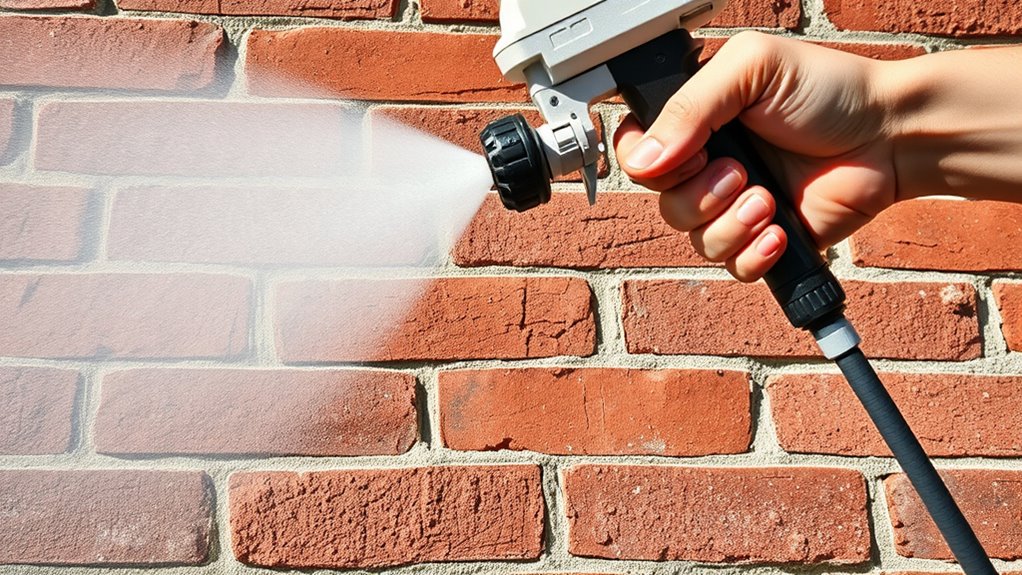
To achieve a smooth and even finish when painting masonry or concrete, proper surface preparation is key. Start by ensuring the surface is clean, dry, and free of debris. Use consistent brush techniques for edges and corners to blend with sprayed areas seamlessly. Maintaining the right paint consistency is essential; if it’s too thick, it can cause uneven coverage, while too thin may lead to drips. Mix your paint thoroughly and test its flow before spraying. Keep a steady hand and overlap each pass slightly to avoid streaks. Adjust your airless sprayer’s pressure if needed to control the spray pattern. Taking these steps will help you achieve a professional-looking, uniform finish with minimal effort.
Cleaning and Maintaining Your Airless Sprayer After Use
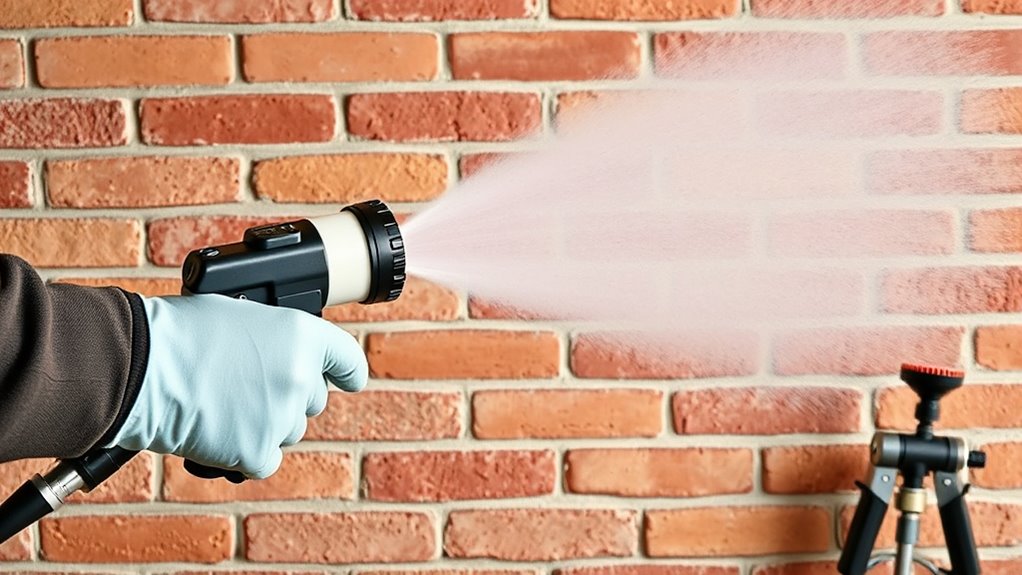
After finishing your project, it’s essential to clean your airless sprayer properly to keep it in top condition. Follow a regular maintenance schedule to prevent clogs and ensure smooth operation next time. Proper cleaning techniques will save you time and extend the life of your equipment. Incorporating proper cleaning methods can help maintain optimal performance and prevent residual paint buildup.
Proper Cleaning Techniques
Proper cleaning of your airless sprayer is essential to guarantee it remains in good working condition and delivers consistent results. After each use, flush the system with solvent or water, depending on your paint type. Use brush techniques to thoroughly clean the spray tip and nozzle, removing any residual paint that could clog or affect future spray patterns. When cleaning, pay attention to color matching by ensuring no leftover paint mixes with new coatings, which could cause color inconsistencies. Disassemble parts as needed and scrub carefully to prevent buildup. Wipe down the exterior to remove drips or splatters. Proper cleaning helps maintain ideal spray performance, extends the lifespan of your equipment, and ensures your masonry and concrete projects look professional and uniform. Regular maintenance, including checking for blockages or leaks, is crucial for optimal operation.
Regular Maintenance Schedule
Maintaining your airless sprayer regularly guarantees it stays in top condition and ready for your next project. Proper cleaning after each use ensures ideal surface texture and paint adhesion, preventing clogs and paint buildup. Consistent maintenance helps preserve the sprayer’s performance and extends its lifespan. Additionally, following manufacturer-specific retirement planning guidelines can help you maximize your investment in the equipment and plan for future upgrades.
- Rinse the spray gun and hose thoroughly with solvent or water, depending on your paint type
- Check and replace worn seals and filters for consistent spray quality
- Lubricate moving parts to prevent corrosion and ensure smooth operation
- Store the sprayer in a clean, dry place to avoid damage and buildup
Following these steps keeps your sprayer in excellent shape, ensuring smooth application and a flawless finish on masonry and concrete surfaces.
Troubleshooting Common Issues During Masonry and Concrete Painting
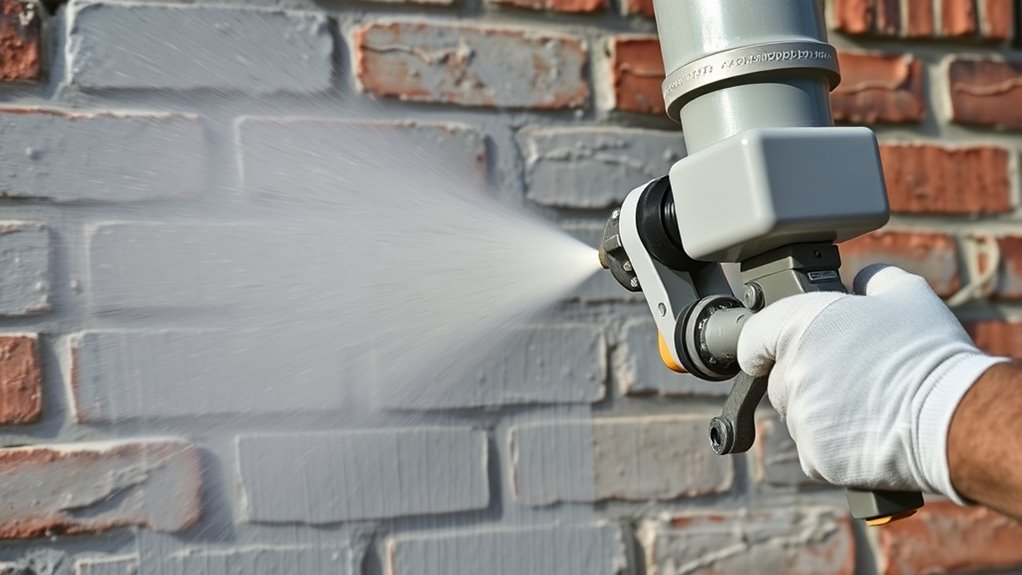
Troubleshooting common issues during masonry and concrete painting can guarantee you time and secure a professional finish. One common problem is poor surface adhesion, which can occur if the surface isn’t properly prepared or if the paint isn’t compatible with the substrate. Ensure the surface is clean, dry, and free of dust or loose particles before painting. Always check paint compatibility—using the wrong type can lead to peeling or cracking. If you notice paint isn’t sticking well, strip and sand the area, then apply a suitable primer designed for masonry or concrete. Adjust your spray technique to ensure even coverage without overspraying or pooling. Identifying and addressing these issues early helps prevent costly rework and results in a durable, smooth finish. Additionally, selecting the appropriate wall organization systems can improve the overall durability and appearance of your painted surfaces.
Frequently Asked Questions
How Do I Choose the Right Nozzle Size for Concrete Surfaces?
Choosing the right nozzle size is essential for effective spray pattern adjustment and achieving a smooth finish. You should consider the surface texture and project size, opting for a larger nozzle for rough or porous concrete to guarantee proper coverage. Smaller nozzles work well for detail work or thinner coats. Always test your nozzle size first, and adjust spray pattern settings accordingly to get even, consistent results without overspray or missed spots.
Can I Use Latex Paint With an Airless Sprayer on Masonry?
Did you know latex paint offers excellent flexibility, making it a good choice for masonry? You can use it with an airless sprayer, but surface preparation is key. Clean and prime the surface properly to guarantee paint adhesion. Use the right nozzle size for even coverage. With proper prep, latex paint adheres well and provides a durable finish on masonry using your airless sprayer.
What Safety Gear Is Recommended When Spraying Masonry?
When spraying masonry, you should wear protective clothing to guard against paint splatters and dust. A respirator mask is essential to prevent inhaling fumes and fine particles. Make sure your gear fits well and covers your skin. Always work in a well-ventilated area, and follow safety guidelines to protect yourself from potential hazards. Proper safety gear keeps you safe and guarantees a smooth, efficient painting process.
How Do Weather Conditions Affect Airless Spraying on Concrete?
Weather worries can whirl you into a whirlwind of woes. High humidity effects can hinder proper drying, causing paint to peel or blister. Wind considerations can whip the spray, leading to uneven coverage or overspray. You should check weather forecasts, avoid spraying during rain, and pick calm, dry days. By understanding these weather whims, you guarantee a smooth, successful spray, securing a stunning, long-lasting finish on your concrete or masonry.
Is It Possible to Paint Textured or Patterned Masonry Surfaces?
Yes, you can paint textured or patterned masonry surfaces, but proper surface preparation is crucial. You’ll want to clean and repair the surface first to guarantee good adhesion. Use techniques like texture enhancement to highlight or preserve patterns. An airless sprayer works well, but adjust your spray settings for even coverage on textured surfaces. Proper preparation ensures your finish looks professional and lasts longer.
Conclusion
Now that you know the secrets to painting masonry and concrete with an airless sprayer, you’re ready to take on any project. But remember, every surface holds its own challenge, and your next masterpiece might just be waiting around the corner. Will you master the technique and achieve that flawless finish? The tools are in your hands—what will you create next? The finish line is near, but the real achievement begins with your next bold stroke.

